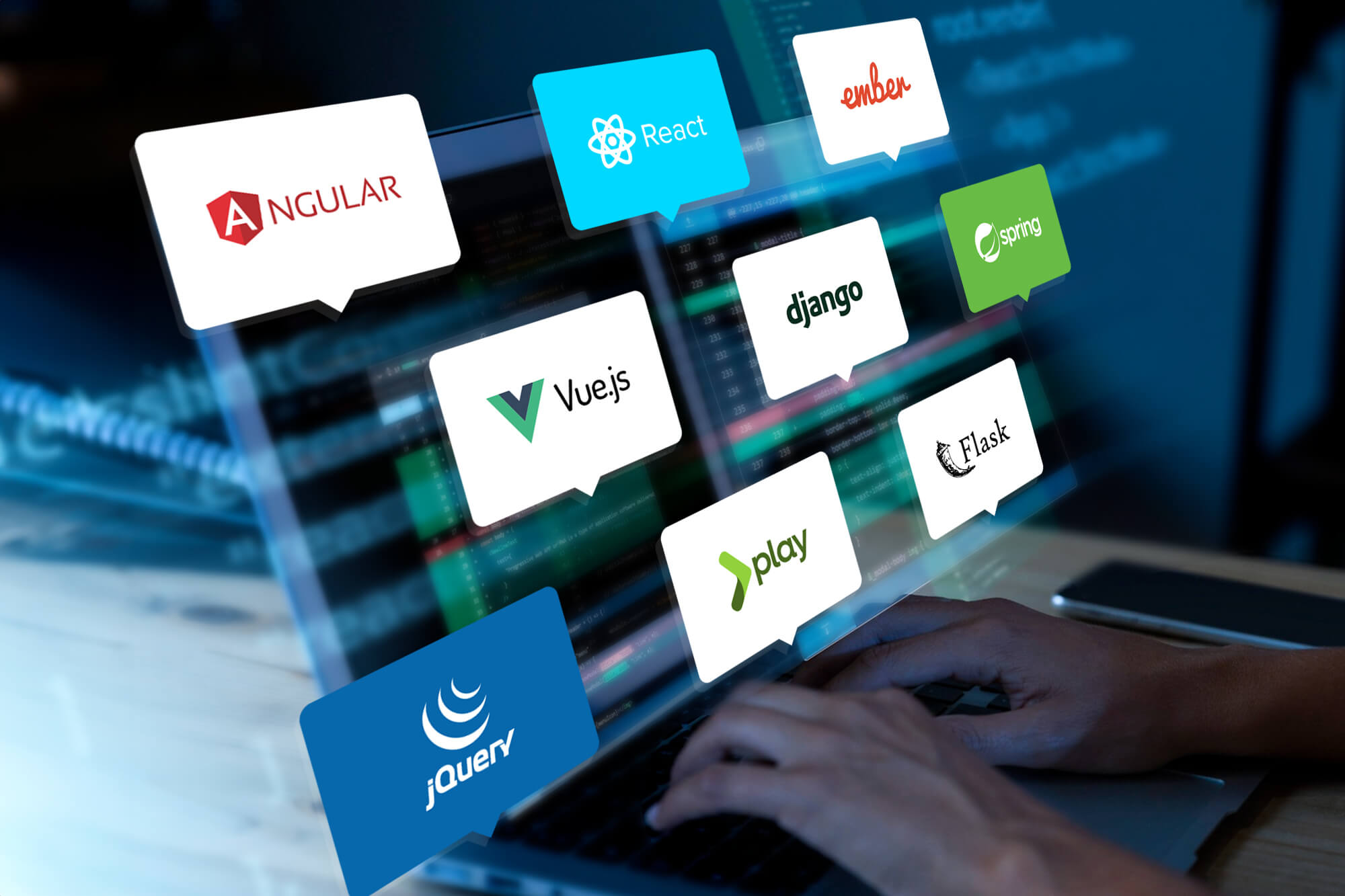
What Are Some Of The Best Software Development Frameworks of 2024?
Jerry Wallis
16 min read

Software development frameworks are indispensable tools for developers. They provide a structured approach to software creation and ensure consistency and organisation within codebases.
In this overview, we’ll explore some of the most anticipated software development frameworks of this year. But first, let’s delve into what constitutes a development framework, its advantages and disadvantages, and how to select the most appropriate framework for your projects.
Defining Software Development Frameworks ⚙️
Before we delve into the specific technologies, let’s answer a simple question, what is a software development framework?
A software development framework encompasses applications, products, or systems that furnish a suite of components for diverse applications, thereby streamlining the development process in terms of time and cost.
These frameworks often furnish common functionalities such as logging and authentication, are shared across multiple applications, and are tailored to address specific problem domains, aiding the development process.
Frameworks cater to the development of desktop, mobile, and web-based applications, with variations available depending on the programming language employed. Popular examples include Django for Python, Laravel for PHP, and Ruby on Rails for Ruby, each offering its unique toolkit and documentation.
Most frameworks facilitate coding in a specific programming language, adhering to well-defined architectures or patterns, which simplify application creation and modification. Also referred to as web app development frameworks, they equip developers with the necessary tools to build intricate web applications, ranging from social media platforms to e-commerce stores.
What Does a Software Framework Include? 🤓
A development framework comprises a reusable set of libraries, templates, and tools designed to streamline development efforts. Like other frameworks, software development frameworks aim to expedite project initiation by furnishing generic functionalities, thereby obviating the need for developers to implement them from scratch.
Furthermore, these frameworks provide an architectural blueprint, design methodologies, and a repository of components such as utility classes and helpers, often accompanied by guidelines on code structuring and framework utilisation.
In essence, a software framework is an abstraction that provides a structured environment for developing applications. It offers a set of guidelines, libraries, and tools that simplify the development process by abstracting common functionalities.
Here are the key components and characteristics of software frameworks:
Generic Functionality: A development framework provides a foundation with generic functionality that can be selectively modified or extended by additional user-written code. This allows developers to focus on application-specific logic rather than low-level details.
Components and Libraries of a Software Development Framework 📲
Support Programs: These are auxiliary tools or utilities that assist in various tasks during development.
Compilers: Frameworks often include compilers to translate high-level code into machine-readable instructions.
Code Libraries: These pre-built code modules offer reusable functionality, saving developers time and effort.
Toolsets: Frameworks come with tools for debugging, profiling, and other development tasks.
Application Programming Interfaces (APIs): APIs define how different components interact within the framework.
Inversion of Control (IoC): Unlike standard libraries or user applications, the flow of control in a framework is dictated by the framework itself. IoC is achieved through patterns like the Template Method Pattern, in which the framework determines the overall program flow.
Default Behavior: Software development frameworks provide default behaviour through invariant methods in abstract classes. Developers can build upon this behaviour by extending or overriding specific methods.
Extensibility: Users can extend the framework by selectively overriding methods or adding specialised code. Hook methods, for example, allow developers to customise specific functionality.
Non-Modifiable Framework Code: While users can extend the framework, they cannot modify its core code. This separation ensures stability and consistency across projects.
Rationale Behind Software Development Frameworks 🤔
Frameworks aim to reduce development time by allowing developers to focus on meeting requirements rather than dealing with low-level details. For example, a web framework lets developers concentrate on banking-specific code rather than handling request mechanics. However, it’s also possible, and has been observed, that some frameworks have introduced code bloat or require additional learning time.
Benefits of Using a Software Development Framework 👍
Software development frameworks offer numerous benefits to developers, enhancing development efficiency, standardisation, security, productivity, and collaboration.
By leveraging a development framework, developers can elevate the quality and pace of their work while minimising resource expenditures. Key advantages of software frameworks include:
Easier Development and Maintenance 👨🔧
Frameworks furnish a stable, well-defined structure for applications, alongside libraries of reusable code, simplifying both creation and maintenance processes.
Standardisation and Compatibility 🧰
Frameworks standardise development practices across organisations and support multiple programming languages, facilitating seamless transitions between projects.
Improved Security 🔒
By streamlining input validation, communication protocols, and access control mechanisms, frameworks bolster application security, mitigating common vulnerabilities.
Increased Productivity 🔁
Frameworks encapsulate best practices and offer reusable code, enabling developers to focus on core functionalities and expedite project completion.
Easier Collaboration 🤝
Frameworks foster collaboration by providing a common toolset and support for version control, enhancing team coordination and project management.
Advantages of Using Software Development Frameworks 🔥
Consistent Code: Frameworks ensure consistent utilisation of code elements, minimising errors and optimising development workflows.
Code Reuse: Frameworks enable code reuse, reducing redundancy and accelerating development cycles.
Consistent Behavior: Frameworks promote consistency within codebases, fostering predictability and maintainability.
Increased Productivity: Frameworks expedite development tasks and promote code quality, enhancing long-term productivity.
Disadvantages of Using Software Development Frameworks 😲
Increased Complexity: Complex frameworks may entail steep learning curves, potentially impeding development efficiency.
Lock-In: Frameworks may restrict flexibility and hinder adherence to best practices, necessitating careful evaluation before adoption.
Increased Learning Curves: Learning new frameworks requires a time investment, potentially delaying project timelines.
Limited Flexibility: Frameworks may lack flexibility, complicating customisation for unique project requirements.
Dependency on Third-Party Libraries: Frameworks rely on external libraries, posing risks if dependencies become obsolete or unsupported.
How to Choose a Suitable Development Framework? 🤓
When selecting a software development framework, consider factors such as programming language compatibility, community support, maturity, and suitability for your project requirements. Steps to guide your decision-making process include:
Evaluate Language Compatibility: Choose a framework compatible with your preferred programming language, considering factors such as open-source availability and patent restrictions.
Assess Community Support: Opt for frameworks with robust community support, ensuring access to resources, tutorials, and expert advice.
Consider Framework Maturity: Prioritise mature frameworks with established track records and sizable user communities.
Explore Case Studies: Review case studies and example applications to gauge framework suitability for your project requirements.
Trial and Evaluation: Experiment with prospective frameworks to assess compatibility, functionality, and ease of use, enabling informed decision-making.
In essence, selecting a software development framework necessitates careful consideration of various factors to ensure alignment with project objectives and developer capabilities. By following this systematic evaluation criteria, developers can identify the most suitable framework to streamline development workflows and maximise project success.
Exploring The Best Software Development Frameworks of 2024 👨💻
Finally, let’s get to the main agenda of this article. What are some of the best software frameworks for developers to use in 2024? These frameworks play a crucial role in modern web and app development, providing developers with tools and pre-written code to streamline their work. I’ll categorise them into front-end and back-end frameworks for clarity:
Front-End Frameworks
Angular
Angular is a powerful front-end framework maintained by Google. It’s ideal for building dynamic, single-page applications (SPAs). Angular provides a robust ecosystem, including features like dependency injection, component-based architecture, and TypeScript support.
Key Features of Angular:
- Component-Based: Angular promotes modular development by structuring applications into reusable components, facilitating code organisation and maintenance.
- TypeScript: Angular leverages TypeScript, a superset of JavaScript, to enforce strong typing, detect errors during development, and enhance tooling support for developers.
- RxJS Integration: Angular integrates Reactive Extensions for JavaScript (RxJS), enabling reactive programming paradigms for handling asynchronous data streams. RxJS simplifies managing data flow and state changes within Angular applications.
React
Developed by Facebook, React is immensely popular for building user interfaces. It follows a component-based approach and efficiently updates the DOM through its virtual DOM mechanism. React’s vast ecosystem includes libraries like Redux for state management.
Key Features of React:
- Virtual DOM: React employs a virtual DOM mechanism to optimise rendering performance by minimising actual DOM updates, resulting in faster and more efficient UI rendering.
- Reusable Components: React promotes component reusability and composability, allowing developers to encapsulate UI elements into modular components for enhanced code maintainability and scalability.
- React Native: React extends its capabilities to mobile app development through React Native, enabling developers to build cross-platform mobile applications using familiar React principles and components.
Vue.js
Vue.js is a progressive framework that strikes a balance between simplicity and flexibility. It’s easy to integrate into existing projects and offers features like reactivity, component-based development, and a straightforward template syntax.
Key Features of Vue.js:
- Reactivity: Vue.js facilitates reactive data binding, automatically updating the UI in response to data changes, enhancing application responsiveness and user experience.
- Scoped CSS: Vue.js encourages scoped CSS styling for components, preventing style leakage and ensuring better encapsulation and maintainability of styles within Vue.js applications.
- Vue Router: Vue.js includes Vue Router, a routing library that provides seamless client-side routing for single-page applications (SPAs), enabling efficient navigation and state management.
Ember
Ember is an opinionated framework that emphasises convention over configuration. It includes everything you need to build ambitious web applications, from routing to data management. Ember’s strong community and built-in tools make it a solid choice.
Key Features of Ember
- Convention-Driven: Ember follows a convention-over-configuration approach, providing predefined conventions and best practices for consistent and efficient development, reducing decision fatigue, and ensuring project maintainability.
- Ember CLI: Ember CLI is a command-line tool that streamlines application development tasks such as project scaffolding, building, testing, and deployment, enhancing developer productivity and workflow efficiency.
- Glimmer: Ember utilises the Glimmer rendering engine, known for its fast and efficient UI rendering capabilities. This ensures optimal performance and responsiveness for Ember applications.
jQuery
Although not a full-fledged framework, jQuery remains relevant. It simplifies DOM manipulation, event handling, and AJAX requests. While newer frameworks have gained prominence, jQuery continues to be used in legacy projects.
Key Features of jQuery:
- DOM Manipulation: jQuery simplifies DOM manipulation tasks with its concise and intuitive API, allowing developers to manipulate DOM elements, handle events, and traverse the DOM hierarchy efficiently.
- Cross-Browser Compatibility: jQuery abstracts away browser inconsistencies, providing a consistent API for handling cross-browser compatibility issues, and ensuring consistent behavior across different web browsers.
- Plugin Ecosystem: jQuery boasts a vast ecosystem of plugins that extend its functionality and provide additional features and utilities for various web development tasks, enhancing developer productivity and code reusability.
Back-End Development Frameworks 👨💻
Django (Python)
Django is a high-level Python web framework known for its “batteries-included” philosophy. It simplifies database management, authentication, and URL routing. Django’s robust ORM (Object-Relational Mapping) makes working with databases a breeze.
Key Features of Django (Python):
- Admin Interface: Django includes a built-in admin interface for managing site content, offering a user-friendly interface for database administration and content management tasks.
- Security Features: Django incorporates robust security features and mechanisms to mitigate common web security vulnerabilities, such as cross-site scripting (XSS), cross-site request forgery (CSRF), and SQL injection.
- Scalability: Django is designed to scale seamlessly for large-scale applications, offering features such as database sharding, caching, and horizontal scaling capabilities to accommodate growing user bases and traffic loads.
Flask (Python)
Flask is a lightweight Python framework that gives developers more flexibility. It’s minimalistic and doesn’t impose strict structures, making it great for small—to medium-sized projects and APIs.
Key Features of Flask
- Micro Framework: Flask’s micro framework architecture ensures a minimal setup, offering only the essential components required for web development. This lightweight approach allows for quick project initiation and flexibility in tailoring the framework to specific project needs.
- Extensibility: Flask boasts a highly extensible architecture, enabling developers to enhance its functionality through the integration of extensions. With a vibrant ecosystem of Flask extensions, developers can seamlessly integrate additional features and customise behaviour to meet project requirements, enhancing scalability and versatility.
- Jinja2 Templating: Flask renders HTML templates using the Jinja2 templating engine, renowned for its flexibility and simplicity. Jinja2 facilitates dynamic content generation in web applications by allowing developers to embed Python code within HTML templates, enabling the creation of dynamic and interactive user interfaces. This templating engine simplifies the presentation layer of Flask applications, promoting code reusability and maintainability.
Play (Java)
Play is a reactive web framework for Java and Scala. It emphasises asynchronous programming and real-time features, and its convention-based approach simplifies development.
Key Features of Play:
- Akka Integration: Play integrates seamlessly with Akka, a powerful toolkit for building concurrent and distributed applications in Java and Scala. Leveraging Akka, Play enables efficient handling of concurrency and scalability requirements, ensuring optimal performance in real-time web applications.
- RESTful APIs: Play provides built-in support for creating RESTful APIs, simplifying the development of web services and APIs. With Play’s RESTful API support, developers can easily define endpoints, handle HTTP requests, and implement resource-oriented architectures, enhancing interoperability and flexibility.
- Hot Reloading: Play offers hot reloading functionality, allowing developers to see instant changes reflected in the application during development. This feature accelerates the development process by eliminating the need for manual reloading, enhancing developer productivity and iteration speed.
Spring Boot (Java)
Spring Boot is a Java-based framework that simplifies building production-ready applications. It provides auto-configuration, which reduces boilerplate code. Spring Boot integrates seamlessly with other Spring projects.
Key Features of Spring Boot
- Auto-Configuration: Spring Boot automates the configuration of common components, reducing boilerplate code and simplifying application setup. With auto-configuration, developers can focus on writing business logic rather than configuring infrastructure, streamlining development and improving time-to-market.
- Spring Data JPA: Spring Boot seamlessly integrates with Spring Data JPA, simplifying database access and management using the Java Persistence API (JPA). By providing abstractions for data access operations, Spring Data JPA simplifies database interactions and promotes code reusability, enhancing developer productivity and code maintainability.
- Actuator: Spring Boot includes Actuator, a set of built-in monitoring and management endpoints for monitoring application health, performance, and configuration. With Actuator, developers can easily monitor and manage Spring Boot applications in real time, ensuring optimal performance and reliability.
Ruby on Rails (Ruby)
Ruby on Rails (often called Rails) is a web application framework written in Ruby. It follows the convention over configuration (CoC) principle, emphasising developer productivity. Rails includes everything needed for building web apps, from routing to database management.
Key Features of Ruby on Rails:
- Active Record: Rails includes Active Record, an object-relational mapping (ORM) framework that simplifies database interactions. Through Active Record, developers can model database tables as Ruby classes and perform CRUD operations using intuitive and expressive APIs, enhancing productivity and code readability.
- Scaffolding: Rails offers scaffolding functionality, allowing developers to quickly generate boilerplate code for common tasks such as CRUD operations. With scaffolding, developers can jumpstart application development by generating controllers, views, and models, reducing development time and effort.
- RESTful Routing: Rails follows RESTful conventions for routing, simplifying the handling of HTTP requests and promoting a resource-oriented approach to web application development. With RESTful routing, developers can define routes that map HTTP methods to controller actions, improving code organisation and maintainability.
Express.js (Node.js)
Express.js is a minimalist web application framework for Node.js. It’s lightweight and flexible, allowing developers to create APIs and web servers quickly. Express.js provides middleware for handling requests and responses.
Key Features of Express.js
- Middleware: Express.js allows developers to easily add functionality to the request-response cycle using middleware. Middleware allows developers to intercept and modify incoming requests and outgoing responses, enabling the implementation of custom request processing logic and enhancing application flexibility.
- Routing: Express.js provides a robust routing mechanism for defining routes and handling HTTP requests. With Express.js routing, developers can define route handlers for different URL paths and HTTP methods, enabling the creation of RESTful APIs and web applications with structured and modularized code.
- Template Engines: Express.js supports various template engines such as EJS (Embedded JavaScript) and Pug (formerly known as Jade), enabling developers to render dynamic content in web applications. Template engines allow developers to easily generate HTML dynamically based on data, enhancing the presentation layer of Express.js applications and improving user experience.
Laravel (PHP)
Laravel is a PHP framework known for its elegant syntax and expressive features. It simplifies common tasks like authentication, routing, and caching. Laravel’s ecosystem includes tools like Eloquent ORM and Blade templating.
Key Features of Laravel:
- Eloquent ORM: Laravel includes Eloquent ORM, a powerful and intuitive ORM for interacting with databases. With Eloquent ORM, developers can define database models, perform database queries, and manage relationships using expressive and fluent APIs, enhancing productivity and code readability.
- Artisan CLI: Laravel provides Artisan, with a command-line interface (CLI) tool for automating common development tasks. With Artisan CLI, developers can generate code, run database migrations, and execute tests using simple and intuitive commands, improving development efficiency and workflow automation.
- Blade Templating: Laravel utilises Blade, a powerful and concise templating engine for generating HTML content. With Blade templating, developers can write clean and readable template files with familiar syntax. This enables the creation of dynamic and reusable views and enhances code organisation and maintainability.
Conclusion – Software Development Frameworks Of 2024 😄
Software development frameworks are essential components in modern software engineering. They offer developers a structured approach to application creation across various platforms. Throughout this overview, we’ve explored the definition and components of these frameworks, highlighting their role in streamlining development efforts and ensuring consistency within codebases.
By providing a suite of components and tools, software development frameworks simplify the development process, reducing both time and cost. They offer developers a foundation of generic functionalities, allowing them to focus on application-specific logic rather than low-level details.
In 2024, several anticipated software development frameworks have emerged, catering to diverse programming languages and problem domains. From Django for Python to Laravel for PHP and Ruby on Rails for Ruby, each framework offers its unique toolkit and documentation, empowering developers to build intricate web applications with ease.
As technology continues to evolve, staying informed about the latest advancements in software development frameworks is crucial for developers seeking to enhance their skills and stay competitive in the industry. We encourage you to explore our learning centre for more insightful articles and resources on software and web development, equipping yourself with the knowledge to excel in this dynamic field.
Topics
Published On
May 06, 2024

